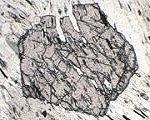Practical Aspects of Mineral Thermobarometry
Phase components and composition space
This section introduces briefly the concepts of end members, additive and exchange components, and substitution vectors. It is also described in Spear's Metamorphic Phase Equilibria Ch 4, pp 75-79.
For many purposes it is convenient to think of mineral composition variation in terms of a multidimensional space. The number of dimensions you need is one less than the smallest number of end members (phase components) you need to describe the full range of possible compositions. For example, olivines (Mg,Fe)2SiO4 need one dimension (a line joining the end members forsterite and fayalite). You can describe the composition of any olivine by choosing one end member composition as an additive component and expressing all the possible substitutions in the form of exchange components.
For simple olivines the only exchange component needed is FeMg-1. It can be thought of as a vector which points from forsterite towards fayalite, and whose magnitude tells us how far in this direction the mineral composition lies.
- Adding 1 unit of this exchange component to forsterite takes us to [FeMg]SiO4, or Fo50.
- Adding 2 units of this exchange component to forsterite takes us all the way to the Fe end member fayalite.
- Adding 0.5 units of this exchange component takes us to Fo75, etc....
Aluminosilicate garnets (Fe,Mn,Mg,Ca)3Al2Si3 need a three-dimensional composition space. If we choose pyrope to be the origin of this space (the additive component), the composition of any garnet is described by three vectors - an amount and a "direction" given by the exchange component. For garnet the logical choices of exchange component vectors are FeMg-1, MnMg-1, and CaMg-1.
To describe coupled substitutions we can define a coupled exchange vector, as for example in the plagioclase series, where the vector relating albite to anorthite is
NaSiCa-1Al-1
or in the tschermak substitution, which occurs in a wide range of silicates, for which the exchange vector can be written
AlviAlivMg-1Si-1
Spear gives a table of common exchange vectors encountered in rock-forming minerals (Table 4.2, p.77).
This page last modified 12 October 2004
